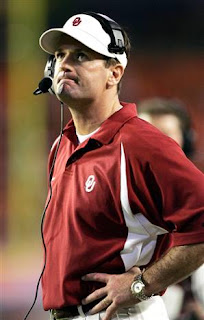Consider the case of coach Bob Stoops and the Oklahoma Sooners.
At this point last year, the Sooners were 9-1. They had recovered from their loss at Texas on October 11, were ranked 5th in the BCS standings, and were awaiting a visit from second-ranked Texas Tech.
When the Sooners demolished the Red Radiers 65-21, they jumped Florida in the BCS, up to third.
The stage was set for a dramatic finish, and the Sooners capped the regular season with a 61-41 win over in-state rival Oklahoma State in Stillwater, and a 62-21 beating of Missouri in the Big 12 Championship game.
The Big 12 win gave Oklahoma enough extra weight in the computer rankings to pass Texas, and, when Florida knocked off top-ranked Alabama in the SEC Championship game, the Sooners found themselves at number one, waiting for an invitation to the national championship to arrive in the mail.
The offense had scored 702 points in 13 games - 54 points per game - and, appropriately, quarterback Sam Bradford won the Heisman Trophy.
Fast forward a year.
In the 2009 season opener, Oklahoma lost Sam Bradford to a shoulder injury, and lost a neutral site shocker to BYU, 14-13. Without Bradford, the offense appeared to be in neutral.
Wins over Idaho State and Tulsa restored some of the Sooner faith, but a 21-20 loss at Miami on October 3 made it clear that blocking was becoming an issue. Three starters from last year's championship offensive line had departed. By then, it was also clear that star tight end Jermaine Gresham's knee injury would sideline him for good.
With freshman Landry Jones at quarterback, Oklahoma managed a few more wins, lost a close one, 16-13, to Texas, and then arrived in Lincoln to play Nebraska on November 7. The offense that had scored more points than any other team in college football history in 2008 could manage only a measley field goal as the Sooners lost 10-3.
Oklaohoma is now 6-4, with games remaining at Texas Tech and at home against Oklahoma State. A 6-6 season is not beyond the realm of possibilities.
This is the reality of college football today. The loss of just a couple of key players can be the difference between dominating and self-destructing.
Most people know this intuitively - ask Florida fans how long they held their breath while Tim Tebow was sprawled motionless on the turf in Lexington - but seldom has it been as apparent as it is with this Sooner squad.

This is what makes Florida's achievements remarkable in this age of parity and unpredictability.
The Gators have now won 20 in a row. It is the nation's longest current winning streak, and includes a 24-14 upset of Oklahoma in last year's national championship game. They have a shot at back to back national championships. If they can keep winning.
It won't be easy. The Nebraska teams of 1994 and '95, the last back to back national champs - and the best college football teams I have ever seen in person - won 26 in a row before losing the second game of the '96 season at Arizona State.
While fans of the 10-0 Gators were admittedly nervous about Tebow's recovery, the really scary thing is knowing that Florida - like any great college team - is always just a couple of plays or a couple of players away from 6-6.





No comments:
Post a Comment